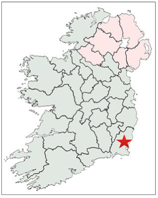
This page highlights the crosses of County Wexford. The crosses are Adamstown, Ballynatray Lower, Ferns (Decorated Shaft, North Cross, West Cross and Northeast Cross), Kilmokea/Great Island, Rossminoge North, and Taghmon/Poulman. The location of County Wexford is indicated by a red star on the map to the left. As an introduction, this paper will also trace the history of human habitation in what is now County Wexford from the Mesolithic Period to about 1200 CE.
Mesolithic Wexford: 5000 to 3000 BCE
In an article simply entitled “Wexford,” Billy Colfer suggests that the first peoples of what is now County Wexford arrived between 5000 and 3000 CE. The evidence he cites is the presence of lithic scatter along the east coast of Ireland. (Colfer, p. 8) These Larnian flints have been found most notably from County Antrim to County Dublin. Britannica online reports that questions have been raised about whether these finds, some of which date to 6000 BCE, should be assigned to the Mesolithic or Neolithic. (Britannica)
Neolithic Wexford: (4000–2400 BCE)
The Neolithic history of what is now County Wexford is much clearer than the mesolithic. It was in the Neolithic that farming began in Ireland. This led to new crops and the domestication of animals such as cows, sheep and goats. Characteristic of this period were stone axes, flint tools, and querns for grinding corn. According to “The Archaeological and Historical Background to a County Wexford Parish,” prepared by Colm Moriarty, a neolithic house with wooden walls and thatched roof was excavated in the parish of Davidstown. Additional evidence of Neolithic habitation was the discovery of a stone axe at Knockduff, Bree. (Moriarty, p. 6)
The website Bree Heritage describes a dolmen at Ballybrittas, on the slopes of Bree Hill, that dates to 4000-2500 BCE. It is described as Wexford’s “oldest standing structure.” There is a second collapsed portal tomb about 8 miles south at Newbawn, near Adamstown. These were burial sites. (Bree Heritage) The drawings below show the Ballybrittas portal tomb and was drawn by George Victor Du Noyer about 1860. (Moriarty, p.11)
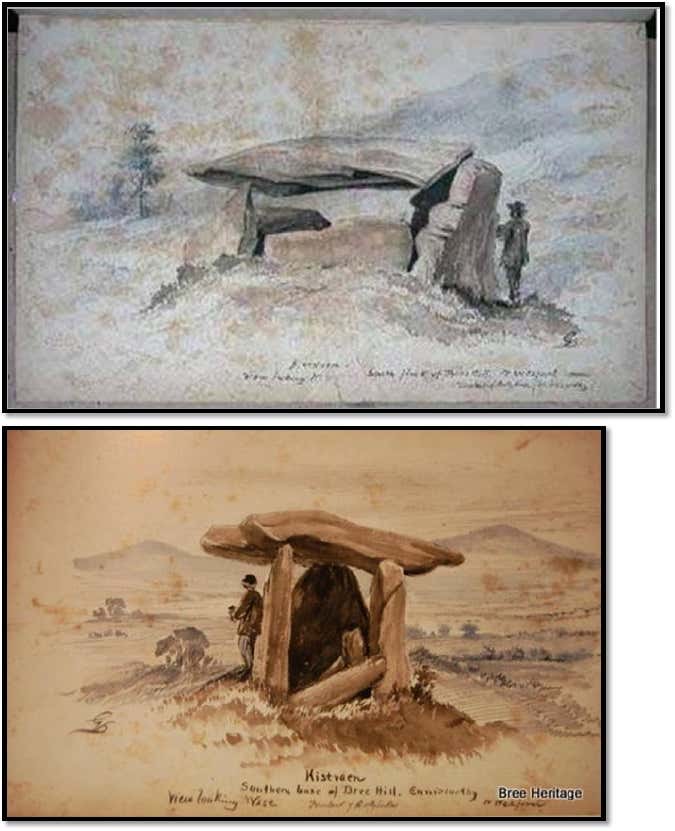
Bronze Age Wexford: (2500-600 BCE)
The Bronze Age saw the advent of working in metals. Gold ornaments, copper and bronze axeheads have been found at Cahore and Carrickshedoge, near New Ross. In addition, a late Bronze Age bronze sword was also found near New Ross. (Colfer, p. 8) At Cahore three axes were found, one of which was later lost. At Carrickshedoge four axes and three pieces of copper cake were found. (Harbison, 1968/9, p. 43) Colm Moriarty identifies a wide variety of Bronze tools and weapons “including axes, swords, spears, knives, halberds, cauldrons and jewelry.” To this must be added objects made of gold “including lunar, docs and bracelets.” Moriarty goes on to suggest that these high status items suggest the presence of a social elite. He goes on to write, “Pottery continued to be used during this period for both domestic and ritual activity, as were flint tools such as arrowheads, knives and scrapers.” (Moriarty, p. 15)
The bronze age sword mentioned above has an interesting story. Following a battle at New Ross during the 1798 uprising against British rule a 2500 year old bronze sword was found in the hand of a dead rebel. It is leaf-shaped and had been modified only by the addition of a crude leather handle. (Looby, 2/3/2018)
Over the course of the Neolithic period, burial rituals changed. Initially there were cist burials with either cremated remains or inhumed bodies. Later, cremation became the norm. Houses were circular with conical roofs. In the Late Bronze Age hillforts began to appear. A hillfort survives at Ballybuckley, while there are a pair of standing stones at Barmoney, fulachta fiadh at Knockduff, a saddle quern at Coolteigue and a bronze axe near Bree village. (Moriarty, p. 16)
The Ballybuckley hillfort mentioned above is one of only two hillforts located in County Wexford. It is 130m in diameter and has an earthen bank that still measures 9-11m in width and as much as 2.2m in height. The few excavations that have been carried out suggest dates of c. 1200-600 BCE. (Moriarty, p. 19)
In the area around the Ballybuckley hillfort are the remains of four burnt mounds that suggest the presence of fulachta fiadh or, as is usually assumed, cooking places. (Moriarty, p. 24)
Iron Age Wexford: 500 BCE to 400 CE
As the name implies, the Iron Age is marked by the arrival of iron smelting and working in iron. It is also the age when the Celts are assumed to have arrived in Ireland. Writing in 1988, Billy Colfer noted that “the evidence for Iron Age activity in Wexford is based mostly on the existence of four promontory forts in the south-west of the county.” He goes on to state that three of these still exist: Nook, Baginbun (Dundomhnaill in medieval timers) and on the Great Saltee. The fourth site, Duncannon is the site of a modern military fort. (Colfer, p. 10) T.J. Westropp, writing in about 1906, described Nook as “A large entrenchment, two banks enclosing a broad headland;” Baginbun as “An entrenched peninsula with a fortified headland to east and two narrow headlands to west.” He also mentioned Duncannon fort as a possible old site but did not mention a site on the Great Saltee. (Westropp, p. 241)
In 2017 the Irish Times reported that skeletal remains were found at Forlorn Point, Kilmore Quay that may date to the Iron Age. In 2007 an archaeobotanical analysis on soil samples from Kerlogue included cereal remains from the Neolithic, Bronze Age, Iron Age and early Middle Ages. Meriel McClatchie’s report focused on ten soil samples from Iron Age deposits. In 2016, a report was published related to archaeology around Ferns. “An Iron Age ring-ditch and Bronze Age pit were uncovered at Ferns Lower.” There were also skeletal remains of seven persons with glass beads. These dated from the 4th century BCE to the 1st century CE. This work is part of ongoing research by the Ferns Research Project. (Ferns Research Project)
In a comprehensive assessment of the history of County Wexford, “Celtic and Early Christian Wexford,” Edward Culleton states that the first Celts to arrive in what is now County Wexford were the Fortharta. They may have been associated with the Brigantes and were of British origin. The Brigantes were the next group to arrive. One of their branches were the Ui Bairrche. The Ui Bairrche and Fortharta controlled much of Wexford and Carlow at the end of the Iron Age, around 400 CE. (Culleton, p. 16)
Early Medieval Wexford: 400-1200 CE
Introduction
The beginning of the Early Medieval period is marked by the arrival of Christianity in Ireland. With the Christian faith came the written word, in the form of Latin. The addition of a written language brought the beginning of documentary sources such as the Irish Annals. Coming out of the Late Iron Age, the country was divided into small kingdoms or tuatha and the economy was focused on livestock farming. Homesteads were dominated by raths or ring forts and duns built mostly in the 7th to 9th centuries. “These are circular or nearly circular enclosures surrounded by one or more earthen banks and ditches of fosses.” (Culleton, p. 58) There were at least 600 of these structures, many of which have been destroyed.
Political History
By the year 500 the Ui Cennselaig were the major tribe in the south of Leinster, having overcome the Ui Bairrche and Fortharta. They claimed to be of the Laigin and traced their descent to Enna Cennselach (Enna the Dominant). (Medieval Ireland)
In the late 6th and early 7th century Brandub mac Echach (d. 605), king of the Ui Cennselaig defended Leinster against the Ui Neill. However, during that time the Ui Dunlainge of North Leinster were the dominant power of the province of Leinster. From 738 the Ui Dunlainge excluded other Laigin dynasties from the providential kingship. During this time the Ui Chennselaig consolidated their power in South Leinster. (Medieval Ireland)
In the 9th century Ui Chennselaig power was focused around Ferns (Ferna Mor Maedoc). There was struggle among some of the branches of the dynasty.The Sfl nOnchon branch provided two kings of the Ui Chennselaig, Tadg mac Diarmata (d. 865) and his brother Cairpre (d. 876). In the 10th century Cairpre’s descendants served as kings of the Ui Chennselaig. (Medieval Ireland)
The 9th century also saw the coming of the Vikings. The Viking settlements at Wexford and Waterford had an impact on the dynastic struggles of the Ui Chennselaig. (Medieval Ireland)
In the 11th century Diarmait Mac Mael na mBo, king of all of Leinster from 1042 to 1072 gained firm control of the Ferns monastery, which was the center of Ui Chennselaig power. The power of the Ui Dunlainge in north Leinster had been weakened by attacks from the Ui Neill, Vikings and the kings of Osraige. (Medieval Ireland) Diarmait Mac Mael na mBo’s descendants took the name Mac Murchada.
In the 12th century Diarmait Mac Murchada, king of Leinster played an important role in politics and in the coming of the Normans to Ireland.
Ecclesiastical History
The Christian faith probably entered Ireland as a result of trade connections with Roman Britain and the Mediterranean world. This occurred as early as the late 4th and early 5th centuries. In 431 the Pope commissioned Bishop Palladius to go to the Irish believers in Christ. His work was in the southeast and was probably more extensive than has often been reported as the supporters of St. Patrick sought to minimize his role. He also seems to have had four other bishops who joined him in 439. They were: Auxilius, Secondinus, Iserninus and Benignus. Their efforts were focused on Leinster.
Christianity had some characteristics in common with Celtic paganism. There was believe in another world, prophetic powers of druids and saints, and the performing of miracles and magic. “The doctrine that wrongdoing was an offense against this new, all-powerful God which could result in eternal damnation if not forgiven, was not easy to accept. However, this was also a loving God who forgave those who truly repented, no matter how many or how serious their sins. The Christian faith did not overtly, exclude anyone from salvation; all people of whatever stratum of society could be saved.” (Culleton, p. 69)
Numerous saint’s lives have been recorded for saints associated with County Wexford. All were written several centuries after the death of the saint and have limited historical value.
St. Ibar of Beggerin was active in the second half of the 5th century. His main church and school was at Beggerin in the Wexford Bay. He was trained by St. Mochta in Louth. Mochta called himself a disciple of St. Patrick. Ibar was active in Meath before moving to Wexford. (Culleton, pp. 80-83)
St. Abban of Adamstown seems to date to the 6th and 7th centuries. He was active in Connacht and Munster before arriving in Leinster. In County Laois he founded a monastery at Killabban. His first foundation in County Wexford was at Magh Arnaidhe, now Adamstown. (Culleton, pp. 98, 99)
St. Aidan or Maedog of Ferns was born around the middle of the 6th century. He studied at St. David’s foundation in Wales during a time when it was controlled by the Deisi of Waterford. Returning to Ireland he founded a number of churches. He was given land at Ferns by Becc, a cousin of Brtandubh, king of Ui Cheinnselaig and Leinster. Ferns was to be the capital of the Ui Cheinnselaig. (Culleton, pp. 103, 104)
St. Munnu or Fintan of Taghmon was active in the 6th and early 7th centuries. He was of the Cinel Conaill of the Northern Ui Neill. He was well educated, having studied at Bangor and at Kilmore in County Roscommon, founded by Columcille, who Fintan knew personally. Following a visit to Iona in 597, he founded churches in Scotland and later was associated with monasteries at Tihelly and Durrow in County Offaly and Taughmon in County Westmeath. The monastery at Taghmon was in territory still controlled by the Ui Bairrche, a non-Ui Cheinnselaig sept. Taghmon takes its name from Teach Munnu, the house of Munnu, shortened over time to Taghmon. (Culleton, pp. 108, 109)
Edward Culleton briefly mentions another dozen saints associated in some way with County Wexford. (Culleton, pp. 126-130)
There were many ecclesiastical sites in what is now County Wexford. According to Edward Culleton, some of these sites were early monasteries and many others were parish churches. The following information is based on three resources: “Map of Monastic Ireland” published by the Ordnance Survey Office; Edward Culleton’s “Celtic and Early Christian Wexford; and “List of monastic houses in County Wexford” on Wikipedia.
Culleton lists four sites that written records affirm as monasteries. These are Ferns, Taghmon, Beggerin and Templeshanbo. Three others, not attested to by records could have been monasteries. These are Clongeen, Killegney and Kilmokea. (Culleton, p. 134) In addition, however, in the “Gazetteer of Early Christian Ecclesiastical Sites in Co. Wexford,” Culleton also gives monastery status to Adamstown (Culleton, p.203), Morrisseysland, New Ross, (probable site of St. Abban’s monastery).(Culleton, p. 212), and a pre-Viking foundation at Wexford Town, known as Selskar, that may have been an early monastery. (Culleton, p. 215)
The Map of Monastic Ireland lists a total of 20 sites, 8 of which are listed as “possible sites.” The “List of Monastic Houses in County Wexford” lists 21 early sites. Also listed in this resource are later foundations of continental orders that, for the most part, arrived with the Normans. In some cases the continental orders foundations were in the same places as earlier monasteries. Each of the three list of monasteries contains some different information than the others.
In the section below on High Crosses, background is provided on the following sites: Adamstown, Ballynatray Lower, Ferns, Kilmokea, Rossminoge North and Taghmon. As noted above, Adamstown and Kilmokea were probably monasteries, while Rossminoge north is listed as the site of a parish church and Ballynatray Lower is not mentioned by Culleton. The cross at Ballynatray Lower may have been moved to its present site from another church or monastery. No information is available on its origins.
Adamstown
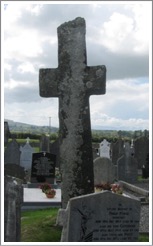

The Cross
This cross is ringless and undecorated. It is approximately twelve feet six inches in height. It stands on a base that is about two and one half feet square at ground level.
The photo to the left shows the south face of the cross while that on the right shows the north face.
The west arm is shorter than the east arm.
The Saint
Tradition connects St. Abban with both Adamstown in County Wexford and Killabban in County Laois. There are five manuscript copies of the Life of Abban. They present some difficulties in determining just when Abban lived, covering a life-span of more than 300 years. The likelyhood is that Abban “belongs to the sixth and seventh centuries, and that his life has been prolonged backwards by local patriotism.” (Culleton, p. 98) Wikipedia ventures a guess that Abban was born about 570 and died in 620. While these dates are uncertain, thay fit with the sixth and seventh century timeframe for Abbans work mentioned above.
Abban seems to have begun his work in Connacht where he is said to have established several foundations. He moved from there to Munster where he is credited with founding churches in Dingle, Co. Kerry and Ballyvourney, Co. Cork. From there he moved to Leinster where he first fouded a monastery at Magh Arnaidhe (the plain of the berries). This is the site now known as Adamstown. The name derives from Adam Devereux, a Norman whose family was granted land there. (Culleton, p. 99)
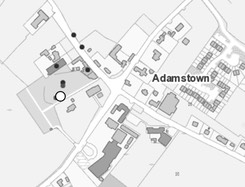
There is no information about the church or monastery itself. If it was founded by St. Abban, in perhaps the early 600’s, and if, as seems likely, it was still in existence during the time of Adam Devereux in the eleventh century, it had a life of at least 400 to 500 years.
Getting There: See Road Atlas page 53 4 C. Located on the R735, the cross is located in a graveyard as indicated on the map to the left.
The map is cropped from the Historic Environment Viewer.
Ballinatray Lower
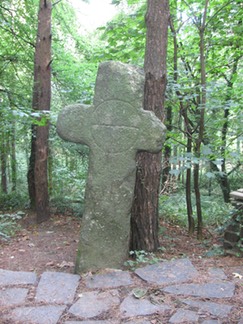
The Cross
This Latin cross is made of shale and has one broken arm. It stands a little over seven feet high. On each side there is an incised cross in a circle. (http://webgis.archaeology.ie/historicenvironment/ item WX012-006)
I find no information at all about the site or any Saint that may be related to it. It is possible, if not likely, that the cross was moved here from another location.
Getting There: See Road Atlas page 54, 1 F. Located north of the R742 on the western outskirts of Courtown. From the R742 take a left where a brown sign reads “Forest Park”. Immediately there will be a left under a low entry barrier into “Forest Park Walking Trails.” As you enter the walking area you will see to your left a sign that directs you to The High Cross of Kilbride.
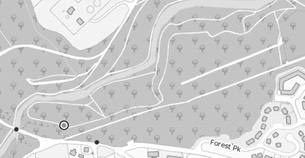
The map is cropped from the Historic Environment Viewer.
Ferns
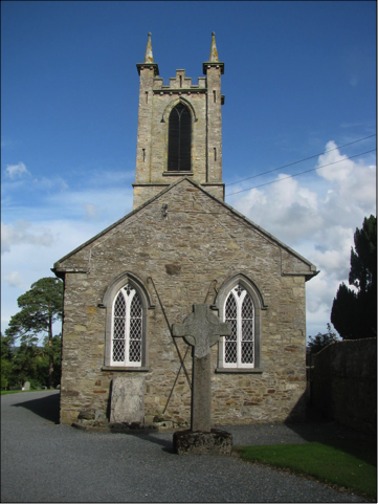
The photo to the left shows the west end of the current Church of Ireland, Saint Edan's (or Aidan's) Cathedral with the west cross in the foreground. (photo 2011)
Introduction to the Site
The area around Ferns, in County Wexford has a long history of recorded habitation. In July 1963 a bronze age cemetery was found at Scarawalsh, about two kilometers southwest of Ferns. (Rynne, p. 39) Ferns itself “is a village that is built upon an old iron age settlement. An archaeological dig in 1999 found a ring ditch that had been in use between 2000-500 BC.” (Holy Well) Herbert Hore, writing in 1910 suggests an etymology for the place name. He said that Fearna mor “signifies ‘a great plain or field’. (Hore p. 302) Wikipedia, on the other hand, reports that Fearna means “alder trees”. (Wikipedia, Ferns, County Wexford)
Our particular interest here is the early Christian habitation at Ferns.
Near the end of the sixth century a nobleman named Becc gave a gift of land to Saint Aidan (also known as Maedog) on which he built a wooden church. Near this same time Brandubh, the Ui Cheinnselaig [a Leinster clan] king of Leinster gifted Aidan with additional land and funds to build a monastery. (Culleton, p. 134) Records exist showing that the monastery was active from around 598 C.E. until at least 1158 C.E. During this period of nearly six hundred years the monastery was guided at times by an abbot and at other times by a bishop. Aidan himself was ordained a bishop in 598 C.E. Both bishops and abbots were appointed with the approval of the local chieftains or kings. (Culleton, p. 135-139)
Ferns was a center for the Ui Cheinnselaig clan at the time the monastery was founded in about 598. Much later, it was the capital of Leinster during the eleventh and twelfth centuries, when, after a period out of power in Leinster, the clan again held the kingship.
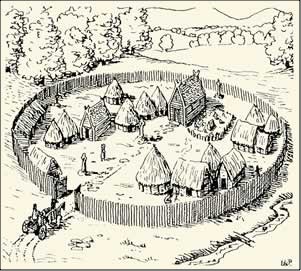 Like many of the early Irish monasteries, Ferns was centered in a circular enclosure. Part of this boundary can still be seen in the remaining surrounding wall. (Meehan, p. 328) The image to the right is not a rendering of what Ferns looked like. It is instead a rendering of a generic early Irish monastery reconstruction by Liam de Paor. The source is: http://www.finlaggan.com/page/24.asp. De Paor, who died in 1998, taught archaeology and history at University College, Dublin and elsewhere.
Like many of the early Irish monasteries, Ferns was centered in a circular enclosure. Part of this boundary can still be seen in the remaining surrounding wall. (Meehan, p. 328) The image to the right is not a rendering of what Ferns looked like. It is instead a rendering of a generic early Irish monastery reconstruction by Liam de Paor. The source is: http://www.finlaggan.com/page/24.asp. De Paor, who died in 1998, taught archaeology and history at University College, Dublin and elsewhere.
The presence of High Crosses at Ferns suggests that it was a prosperous monastery during at least part of its history. This certainly included the eighth and ninth centuries. Peter Harbison suggests a ninth century date for a decorated cross shaft south of the Protestant Cathedral. He suggests that the other three high crosses on the site probably also fit into this earlier groupings of crosses. (Harbison, 1992, p.377) Another sign of the importance of Ferns monastery is found in a mention in 787 of the stone church there. This makes it one of the early stone churches in Ireland. (Meehan, 328)
During the eighth century Ferns and its monastery were involved in a power struggle between two branches of the Ui Cheinnselaig clan. One branch, the Sil Chormaic were in control of the area around Ferns and held the kingship. The other branch, the Sil Maeluidir, were centered around Taghmon (in south Wexford), where a monastery had been founded about the same time as at Ferns. There was military action between the two monasteries in 769 and 783, which probably involved monks fighting monks. In 809 the Sil Maeluidir gained the kingship of Leinster, but not Ferns. “Given the power, prestige and wealth of Ferns this situation had to be remedied. In 817 a major battle was fought between the forces of the monastery of Taghmon, . . . and Ferns, in which 400 people were killed.” (Culleton, p. 138 and Hughes, p. 169)
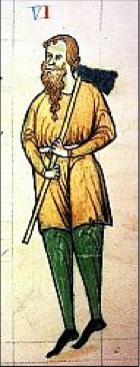
Norwegian Vikings also attacked, sacked and burned Ferns several times in the ninth and tenth centuries. (Askaboutireland)
The Ferns monastery, like many Irish monasteries, was a place of learning. The Annals of the Four Masters for 1129 records the death of Mac Muirgheasa, a lector or professor at Ferns.
By the twelfth century the old monastery was in decline and there may not have been much left of the community. In 1158 Diarmait Mac Murchada, king of Leinster chartered Saint Mary's Augustinian abbey at Ferns. It was build within the grounds of the old monastery. (Furlong, pp. 88-90)
In 1166, Diarmait left Ireland. (Furlong, p. 103) He was forced out by his enemies. The image to the right is of Diarmait. (:http://www.evi.com/q/facts_about__dermot_macmurrough) Before leaving he burned Ferns including his royal palace and the monastery at Ferns. (presumably this included the new Abbey.) In 1169 Diarmait returned to Ireland with the support of the Normans. Upon his return, he rebuilt Ferns. (Meehan, p. 329) Thus he holds the dubious distinction of being the Irish king who invited the Normans to Ireland. He died at Ferns in 1171 and the decorated cross shaft south of the Protestant Cathedral is said to mark his grave.
Introduction to the Founding Saint
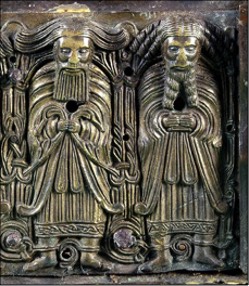
The monastery at Ferns was founded by Saint Aidan, also known as Maedog. Aidan was born in Co. Cavan around the middle of the sixth century. He was of noble birth. He studied for a time at Saint David’s monastery in South Wales. As stated above land at Ferns was given to Aidan by the nobleman Becc and the Ui Cheinnselaig king Brandubh. Aidan was given the title of Bishop of Ferns by Brandubh in thanks for his prayers that had led Brandubh to victory in war. (Meehan, p. 328) "His name, Aedh, prefixed by “Mo" and ended with “og", both affectionate terms, became locally 'Mogue', but in its English diminutive, it becomes 'Aedhin' or 'Aidan'." (Meehan, p. 327) You will also find additional spellings of his name.
The image to the left is a detail from the Breach Maodhog associated with St. Aidan of Ferns. "The Breach Maodhog (the speckled or variegated shrine of Saint Maedoc . . ) is a house-shaped reliquary, probably made in the late 11th century." http://www.100objects.ie/portfolio_category/national-museum/. Photo http://www.facebook.com/irisharchaeology.ie/posts/325749244208592, 3/27/2013. It is unclear who the figures represent.
The Ferns monastery probably followed the pattern of life at St David’s in Wales. “Each monk toiled at daily labour, they ‘dig the ground with mattocks and spades, carry in their holy hands hoes and saws for cutting, provide with their own industry all the necessities of the community. The rest of their time is spent in prayer and chanting of the psalms.’” (Culleton, p. 104) Aidan seems to have participated in the manual labor of the community as well as caring for administrative needs.
Like all Saints, miracles of various kinds were atrtributed to Aidan. “When the monastery was being built, his disciples complained that there was no water near the place. Aidan ordered them to cut down a large tree, whereupon a spring gushed forth which was named after the saint.” (Culleton, p. 105) This miracle creates a link between Aidan and Moses, who at God's command struck a rock in the wilderness from which water gushed forth. (Exodus 17:1-7) Such connections with biblical figures are typical of hagiography.
Aidan died around the year 624.
There is a certain amount of confusion around the life of Aidan or Maedog. There was another saint Maedog located nearby at Clonmore in County Carlow. The two lives have probably been conflated. (Culleton, p. 103)
The Crosses
There are parts of four high crosses at Ferns and a much smaller fifth cross that may or may not be pre-thirteenth century. Each of these crosses is described below.
The South cross consists of a decorated shaft and a large base. The West, North and North-east crosses have original heads, all with imperforate ringed heads. They stand on their original bases but the shafts have not survived. These three crosses have been re-erected using concrete shafts. (Harbison, 1992, p. 89) The small cross is east of the Cathedral.
The Decorated Shaft: The South Cross consists of a decorated shaft and a large base. It stands south of the Protestant Cathedral. The base is of granite and measures 1.4 m by 1.17 m. It has “raised moulding on the edges and surrounding the bottom of the shaft.” (Harbison, 1992, p. 89)
The photos below show the south side of the cross (upper left), the north side (upper right), the east face (lower left) and the west face (lower right).
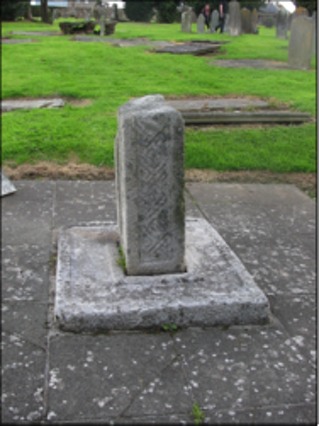
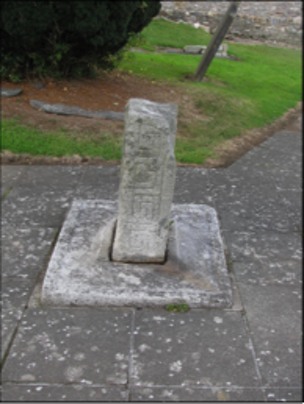
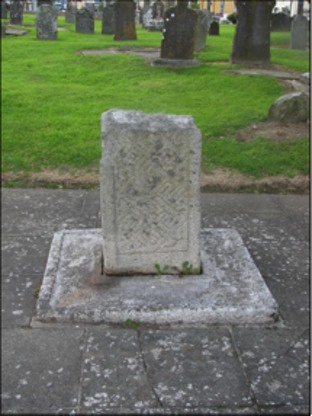
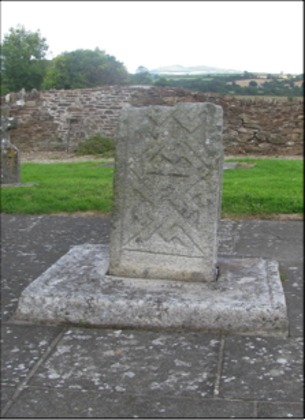
The shaft is of granite and stands 95 cm high. It is 57 cm wide and 34 cm thick. “There are broad raised flattened mouldings at the edges. It has a meander pattern on the south side and fret patterns on the north side, as well as on the two faces.” (Harbison, 1992, p. 89)
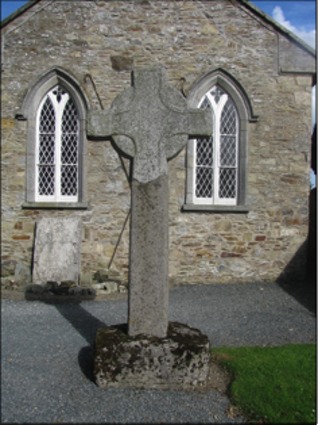
The West Cross: Standing to the west of the Cathedral, this cross consists of the base and the head. It has be erected using a concrete shaft. “this cross-head is 1.12 m high and 1.25 m across the arms. The east face of the cross has no roll moulding. (Harbison, 1992, p. 89) The east face is seen in the photo below. As seen in the photo to the right the shape of the cross is outlined by a roll moulding on the west face of the cross.
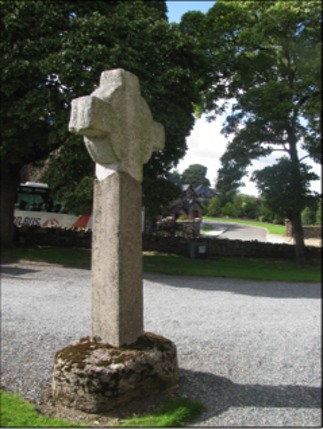
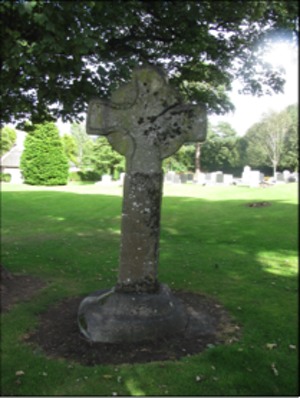
The North Cross: “This cross-head stands near the road, to the north of the Cathedral. It is 1.10 m high and 1.21 m across the arms.” (Harbison, 1992, p. 89) Like the west cross it consists of a base and head connected by a concrete shaft. The size of the head and the outlining of the cross head with roll moulding is very similar to that on the west cross. The photo to the left is the west face of the cross, the one below is the east face.
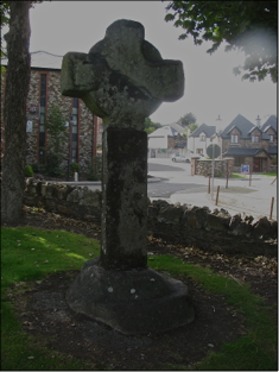
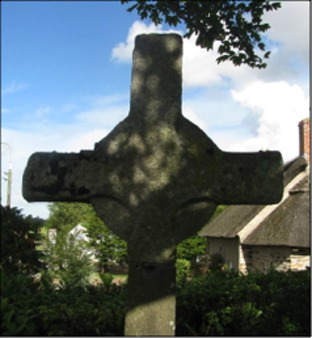
The North-east Cross: “Situated in low-lying ground close to the road, and in the north-eastern part of the Cathedral grounds, this cross-head has narrower and longer arms than the other two, and the ring is framed by a roll moulding at the edges. It is 1.40 m high and 1.53 m across the arms. (Harbison, 1992, p. 89) This cross is larger than the west and north crosses. The arms extend farther from the ring. The photo to the left shows the west face of the cross. The photo below is the east face.
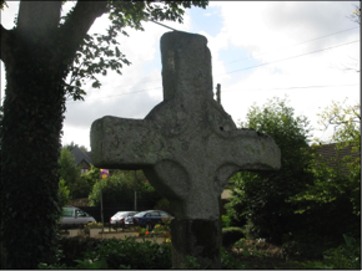
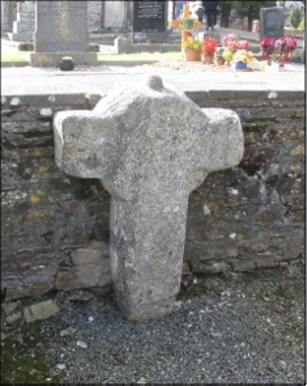
The Small Cross: In Peter Harbison's catelogue of crosses the small cross is not included as it does not fit his criteria for inclusion. It is, however listed in Appendix A along with other crosses that may be pre-thirteenth century but do not meet the criteria. Crosses excluded include those “which are -- or are likely to have been -- less than 1.50 m or about 5 feet in height, and which bear no traces of carving or mouldings, even though they may have simple incised decoration or a ringed outline.” (Harbison, 1992, pp. 393 and 2) The small cross, pictured to the left, is far short of 5 feet tall and has no apparent decoration of any kind.
Saint Mary's Augustinian Abbey
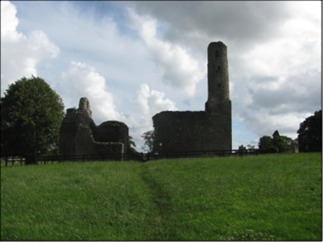
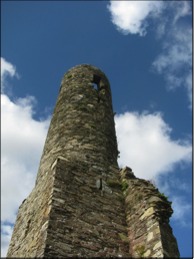
As stated above, Saint Mary's Abbey was chartered by Diarmait Mac Murchada, king of Leinster. There is some disagreement among writers about exactly when the abbey was founded. Brian Lalor gives a date of 1152 for the founding. "In 1152 MacMurrough founded St Mary's Abbey for the Canons Regular. This was burned by the O'Rourkes and O'Connors, but he rebuilt it in 1160, following his return from his appeal to Henry II." (Lalor, p. 229) Nicholas Furlong states that the abbey was chartered in 1158. He provides the text of the original charter. (Furlong, p. 88f) He also reports that in 1165, during a time of peace, fire destroyed Ferns except for the castle, monastery, cathedral and churches that were constructed of stone. (Furlong, p. 95) In 1166, before leaving Ireland, Mac Murchada himself had Ferns burned again. (Furlong, p. 99) Cary Meehan reports that "on his return in 1169, with Norman support, he rebuilt Ferns and founded an Augustinian Abbey on the site of the original monastery." (Meehan p. 329) Lalor seems to be off in his dating both of the abbey and of Diarmait's return from England. Furlong's record of events has greater credibility as it is reported in a life of Diarmait that explores events of that time in considerable detail.
One thing that can be agreed on is that the abbey has an unusual round tower. It is built into the northwest corner of the abbey church. From the ground to the eaves of the building it is rectangular in shape. Above the eaves it becomes round in shape. Brian Lalor states "This is the sole example of an attached tower which survives relatively intact." (Lalor, p. 229) He adds that it probably had a conical top.
The abbey was suppressed between 1536 and 1541 by order of Henry VIII.
Medieval Cathedral
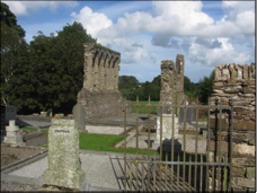
East of the present Church of Ireland Cathedral, Saint Enda,' stand the ruins of a medieval cathedral built by Bishop John Saint John about 1220. It was in the Gothic style. (http://www.fernsvillage.ie/ferns-heritage-page53915.html)
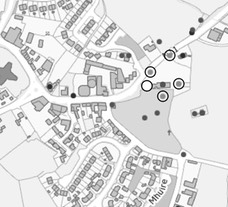
Getting There: See Road Atlas page 54 2 E. Located on the N 11 The crosses are indicated by the circles on the map to the right.
The map is cropped from the Historic Environment Viewer.
Kilmokea, Great Island
The Site
Kilmokea is located on Great Island. Habitation of the island commenced about 10,000 BCE. In the 7th century a monastery was founded at Kilmokea that covered 20 acres. In the graveyard there, in addition to the high cross, are bullaun stones and the remains of a horizontal water-mill. A church was founded here in the 8th century by Suadbar. The site is also associated with Saints Findbarr and Barrfhin.
The Cross
The cross at Kilmokea is quite small, measuring just under two feet in height. It is made of sandstone, is imperforate and has "rope-moulding around the edges and around the cross in the centre of the what is now the west face, as well as around the panels on the ends of the arms.” (Harbison, 1992, p. 131) The photos to left and right above were taken by Paddy Healy. (Harbison, 1992, Vol. 2, Figs. 438-440; the descriptions below are derived from Harbison, 1992, p. 131)
East Face (photo to the right)
This face has a crudely shaped cross that dominates the entire face of the cross. Inside the center of the cross is a double incised circle with an equal armed cross within that has X-shaped decorations on the arms. (Harbison, 1992, p. 131)
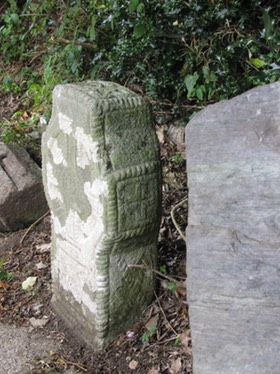
South Side (photo to the left)
Rope moulding frames this entire side of the cross. In addition rope moulding on the shaft forms an X. On the end of the arm is an equal-armed cross that is raised and has an incised cross inside.
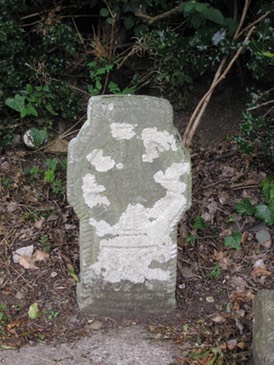
West Face (photo to the left)
Once again, rope moulding is used extensively. On the shaft is a panel of interlace. On the head is an equal-armed cross with rope-moulding at the edges. There is an incised cross on each arm of the equal-armed cross and a cross-decorated boss in the center surrounded by rope moulding. An inscription runs around the top of the cross. The inscription cannot be deciphered.
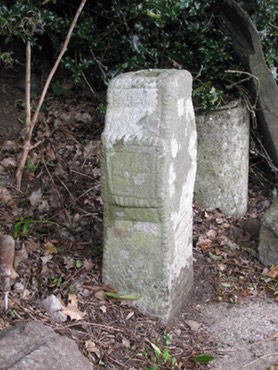
North Side (photo to the right)
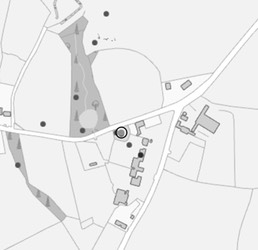
This side is similar to the south side. A panel of interlace can be seen on the flat top of the cross.
Getting There: See the Road Atlas page 63, 2 B. Take the R733 south from New Ross. Follow the signs for the Kilmokea Gardens. The cross is located in a small graveyard that is on a side road just before you come to the Gardens. Turn right and you will see a graveyard on your left.
The map to the right is cropped from the Historic Environmental Viewer.

Rossminoge North Cross-head
The only reference I find to this cross-head is in the Historic Environment Viewer. The description there is as follows: “Located on a gentle E facing slope. The parish church of Rossminoge is within a rectangular graveyard defined by an earthen bank, which has a fosse or ditch inside it on the SE side. In the SW corner of graveyard is the ringed but unpierced and undecorated head of a large granite high cross (H 0.93m; With 0l.84m; T c 0.1m), but one of the arms is missing. Compiled by Michael Moore.”
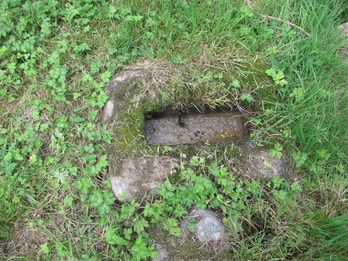
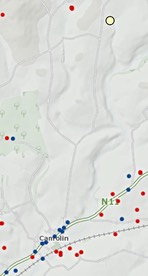
The cross-head is lying partly buried in the ground and is covered with grass and moss. Nearby is the base with a rectangular mortise.
Getting There: See the Road Atlas page 54 E 1. From Camolin along the N11, take an unnamed road north. At the fork in the road, stay right. The road to the site is a one lane drive to a house that is funneled by trees. The cross and base are in a graveyard to the left of the farm buildings. Both are covered with grass and moss.
The map to the left is cropped from the Historic Environmental Viewer.
Resources Consulted:
Historic Environment Viewer, http://webgis.archaeology.ie/historicenvironment/.
Taghmon, Poulman
The Monastery
Saint Munnu founded a monastery at a place called Achadh Liathdrm which means “the field of the grey ridge” on land donated by the local chief, a man named Dimma or Diarmait. The exact year of the founding is not known, however, Munnu died in 635 or 636. The place soon came to be called Teach Munnu or the house or monastic church of Munnu. This was later morphed into Taghmon. (Culleton, pp. 140-141)
The monastery functioned as a school and continued to flourish for several centuries. A number of abbots are mentioned in the Annals, and one additional abbot, Ossine, is mentioned in the Life of Adomnan. These abbots are:
Munnu, d. 636; Ossine, d. 687; Ciaran, d. 777; Crundmael, d. 817; Laisren, d. 854; Fiachra, d. 859; Dunghal (vice-abbot), d. 885; Diarmaid, d. 886; Cochlan, d. 889; Soichleachan, d. 925; and Dunlang Mac Donnagain, d. 953. (Culleton, p. 141)
The Annals record that in 828, “Cairpre, son of Cathal, king of Ui Cheinnselaig, and the men of Taghmon, defeated the Norse, or Gentiles, as the monks who recorded such attacks named them.” (Culleton, p. 142) It is entirely possible that the men of Taghmon included monks. The Norse later plundered Taghmon in 835 and 921.
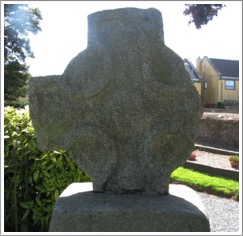
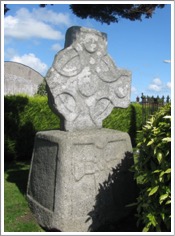
During the 8th and 9th centuries Taghmon was involved in conflict with the monastery at Ferns. That story is told briefly under the history of Ferns above. It was in the 9th century, perhaps as a result of its conflict with Ferns that the monastery began to decline. It continued to exist into and perhaps beyond the 11th century. (Culleton, p. 142)
The Saint
Saint Munnu is also known as Finton. He was born into the Ui Niell clan of Northern Ireland. After 18 years in monastic life in Ireland, he traveled to Iona to serve under Saint Columba. By the time he arrived Columba had died and the new abbot, Baithene, told him that Columba wanted him to depart because he was destined to found a monastery. That monastery was Taghmon. At the synod of Magh Lene in 630, Munnu was a firm supporter of the Celtic liturgical practices in opposition to Saint Laserian and others who preferred the Roman practices. (http://celticsaints.org/2010/1021a.html) This apparently centered around the computation of the date of Easter. (Lanigan, p. 393)
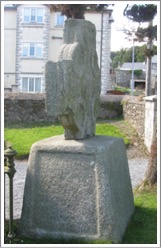
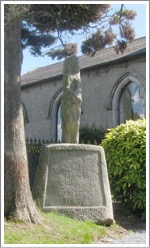
The Cross
All that remains of the cross at Taghmon is the base and the head. The base stands four feet in height. The cross head is four and a half feet tall and a few inches more wide.
The base has decoration only on the south face. There we have a ringless cross in relief with a boss in the center. The arms have expanding terminals.
The head is that of a ringed cross that is imperforate. The ring is outlined by raised ribs. the decoration is the same on both faces. (Harbison, 1992, p. 168)
Other Crosses in or near Taghmon
In October of 2008, Christian Corlett located 14 carved crosses in three locations in or near Taghmon. From their characteristics he identifies them as pre-Norman, possibly being carved in the 10th or 11th centuries. While some of these crosses and been reused as grave markers, the original purpose of the crosses is unknown. (Corlett p. 237)
As one possible explanation for the presence of the crosses Corlett suggests an association with St. Munnu. In his Life “it is said that he marked out his foundation at Taghmon with four crosses.” These may or may not be some of the crosses described below. St. Munnu’s Life may have been compiled in the 12th century or even later. (Corlett p. 237)
The crosses were found in three locations. Twelve of them were found in St. Munna’s graveyard near St. Munn’s Church of Ireland where the well known Taghmon cross is located. One cross was located in the Lady’s Church and Mary’s graveyard in Taghmon. The final cross was found in Whitechurch in Wilkinstown townland north of Taghmon. (Corlett p. 237)
St. Munna’s graveyard Crosses
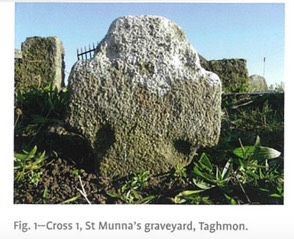
As noted above there are twelve crosses in this graveyard. All are worn and some are damaged. Two exist only as fragments.
Cross 1: Sited west of a central burial enclosure, embedded in the ground and only partly exposed. The head is wheel-shaped and imperforate. On each side there are slightly hollowed angles. The cross is 12 inches (30cm) across 3 inches (8cm) thick and 13 inches (34cm) high, shaft 6.5+ inches (17cm) wide. Photo to the right. (Corlett, pp. 238-239)
Cross 2: Located near cross 1, this is the most elaborate of the crosses. The upper transom is broken away. the lower angles have recessed cusps. These are highlighted by incised lines that continue part of the way down the shaft. Cusps probably appeared on the upper angles as well. The cross is 26 inches (67cm) high, 13 inches (34cm) across and 3 inches (8cm) thick. The shaft is 5.5 inches (14cm) wide. Photo below left, illustration below right. (Corlett, pp. 238-239)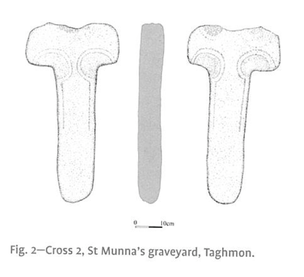
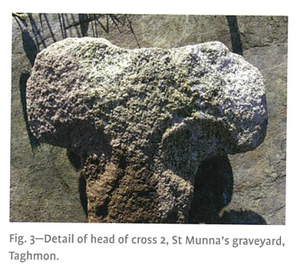
Cross 3: Located under a yew tree. This is the largest of the crosses. The angles have recessed cusps on both sides. The cross measures 33 inches (84cm) high, 16 inches (40cm) across and nearly 5 inches (12cm) thick. The shaft is 6.5+ inches (17cm) wide. Pictured to the left below, illustration pictured to the right below. (Corlett pp. 238-239)
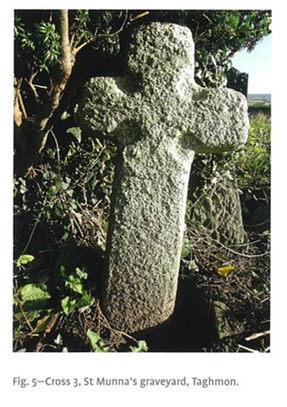
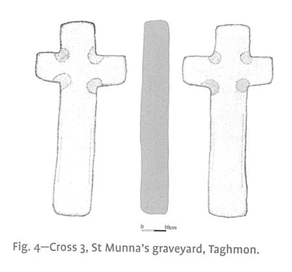
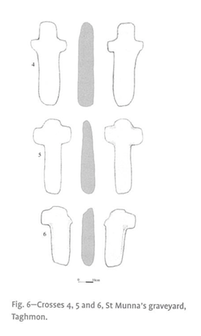
Cross 4: Located west of the central burial enclosure, near a conglomerate millstone. This is a plain cross with one arm slightly broken. The cross measures 23.5 inches (60cm) high, 10 inches 925cm) wide and 4 inches (10cm) thick. The shaft is 6 inches (16cm) wide. Illustration at the top of the panel to the right. (Corlett, pp. 238-239)
Cross 5: Sited in the western quadrant of the graveyard near cross #4. Angles have shallow recessed cusps on one side with the other side plain. The cross measures 20 inches (51cm) high, 10 inches (25cm) across and 2-3 inches (5-8cm) thick. The shaft is 4 inches (11cm) wide. Illustration in the center of the panel to the right. (Corlett, pp. 238-239)
Cross 6: Located near the graveyard boundary in the north-west corner. This is the smallest of the crosses. The upper transom is missing and it is possible the cross was originally a T- or tau-shaped cross. The cross measures 17 inches (43cm) high, 8 inches (20.5cm) across and 3 inches (7cm) thick. The shaft is 4+ inches (11cm) wide. Illustration at the bottom of the panel above right. (Corlett, pp. 238-239)

Cross 7: Sited in the southern quadrant of the graveyard, this is part of the broken head of a cross. There are traces of recessed cusps in the angles on one face while the other face is plain. The cross is 7.5 inches (19cm) high, 8 inches (21cm) across and 2 inches (5cm) thick. There is no shaft. The illustration is at the bottom of the illustrations to the left. (Corlett, pp. 240-241)
Cross 8: Located in the southern quadrant of the graveyard. The upper transom and shaft are missing. The four angles are cusped. Found near cross #7. 4.5+ inches (12cm) high, 11 inches (28cm) across and 3 inches (7cm) thick. Illustrated to the left by the upper two illustrations. (Corlett, pp. 240-241)
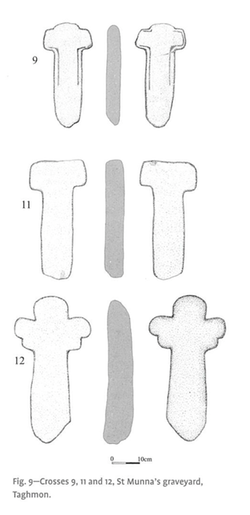
Cross 9: Sited in the southern quadrant of graveyard. The upper transom is missing. There is an outline of a cross on both sides. The cross is 15 inches (38cm) high, 7 inches (18cm) across and 5cm thick. shaft 10.5cm wide. This cross is illustrated in the upper image of the illustration to the right. (Corlett, pp. 240-241)

Cross 10: eastern quadrant, firmly embedded in ground, partially exposed, 13 inches (34cm) across, 2.5 inches (6.5cm) thick, 16 inches (41cm) high. The shaft is 6 inches (16cm) wide. The angles have recessed cusps on both faces. This cross is illustrated in the photo to the left. (Corlett, pp. 240-241)
Cross 11: This cross is located in the north-eastern quadrant of the graveyard. One arm is broken off as well as the upper transom. The edges of the cross are lightly recessed and there are traces of recessed cusps in one angle on each side. The cross measures 16 inches (40cm) high, 8.5 inches (22cm) across and 3 inches (8cm) thick. The shaft is 5 inches (13cm) wide. This cross is illustrated by the middle figures in the illustration to the right. (Corlett, pp. 240-241)
Cross 12: Sited in the south-eastern quadrant of the graveyard. One face is plain and flat, the other is slightly rounded. The head also rounded, and the arms are staggered in “stylised representation of the outstretched arms of the Crucifixion scene.” Could be later than the others on this site.; 21 inches (54cm) high, 11 inches (28cm) across and 4 inches (10cm) thick. The shaft is 5-6 inches (12.5-15cm) wide. This cross is illustrated by the lower figures in the illustration above right. (Corlett, pp. 240 and 242)
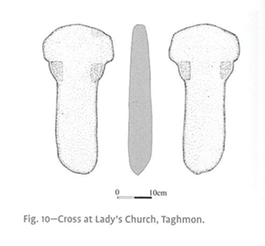
Lady’s Church, Taghmon
This is a granite cross in north-western quadrant of the Lady’s Church graveyard. It was reused as burial-marker. The upper transom is missing, the head is wheel shaped. The lower angles are slightly hollowed and the ring is imperforate. The cross is 17 inches (44cm) high, 8 inches (21cm) across and 2+ inches (6cm) thick. The shaft nearly 5 inches (12cm) wide. This cross is illustrated in the drawing to the right. (Corlett, pp. 240 and 242)
Whitechurch, Wilkinstown
This is a granite cross lying near the western quadrant of graveyard. Lower angles on both faces have recessed cusps. The cross measures 34 inches (86cm) high, 16 inches (40cm) across and 6.5+ inches (17cm) thick. The shaft is 8 inches (21cm) wide. The cross is pictured and illustrated in the panel below. (Corlett, pp. 241-242)
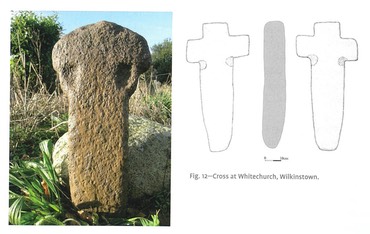
Getting There: See the Road Atlas page 53 5 D. Taghmon is just west of the R738. The crosses are located at St. Munn's Church of Ireland in Taghmon, just inside the gate of the church; at St. Munna’s graveyard nearby; at the Lady’s Church graveyard in Taghmon and at a graveyard Whitechurch in Wilkinson townland north of Taghmon.
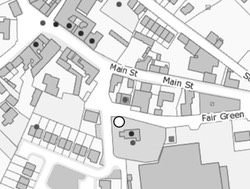
The map is cropped from the Historic Environment Viewer and shows the location of St. Munn’s Church of Ireland. Ask locals for direction to the other three graveyards.
Resources Consulted:
Askaboutireland: http://www.askaboutireland.ie/learning-zone/primary-students/looking-at-places/wexford/aspects-of-county-wexford/ferns/
Celt, Corpus of Electronic Texts, http://www.ucc.ie/celt/publishd.html, Annals of the Four Masters.
Celtic Saints, http://celticsaints.org/2010/1021a.html.
Corlett, Christian, The Taghmon crosses, Co. Wexford, In M. Davies, U. MacConville & G. Cooney (eds) A Grand Gallimaufry collected in honour of Nick Maxwell, 237-42., 2010
Culleton, Edward, Celtic and Early Christian Wexford, Four Courts Press, Dublin, 1999.
Ferns, County Wexford: https://en.wikipedia.org/wiki/Ferns,_County_Wexford
Ferns Heritage: http://www.fernsvillage.ie/ferns-heritage-page53915.html
Furlong, Nicholas, Diarmait: King of Leinster, Mercier Press, Douglas Village, Cork, 2006.
Harbison, Peter; "The High Crosses of Ireland: An Iconographical and Photographic Survey", Dr. Rudolf Habelt GMBH, Bonn, 1992. Volume 1: Text, Volume 2: Photographic Survey; Volume 3: Illustrations of Comparative Iconography.
Holy Well: Saint Mogue’s Well, Ferns, http://irelandsholywells.blogspot.com/2011/09/saint-mogues-well-ferns.html
Hore, Herbert F., “Ferns, Co. Wexford”, Journal of the Royal Society of Antiquaries of Ireland, Fifth Series, Vol. 40, No. 4 December 31, 1910.
Hughes, Kathleen, The Church in Early Irish Society, Cornell University Press, Ithaca, N.Y., 1966.
Lalor, Brian, The Irish Round Tower, The Collins Press, Cork, Ireland, 1999.
Lanigan, John, An Ecclesiastical History of Ireland, 1923.
Meehan, Cary, The Traveller’s Guide to Sacred Ireland, Gothic Image Publications, Gastonbury, Somerset, England, 2002.
National Monument Service: http://webgis.archaeology.ie/historicenvironment/ item WX012-006
Rynne, Etienne, “Bronze Age Cemetery at Scarawalsh, Co. Wexford”, The Journal of the Royal Society of Antiquaries of Ireland, Vol. 96, No. 1 (1966), page 39.